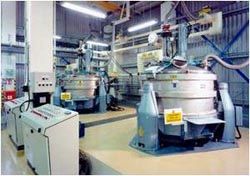|
Ploughing savings
back into production
 A more arduous duty cycle for an inverter than that of the drive of
an industrial centrifuge is hard to imagine. A plough which scrapes
the solids from the walls of the basket of the centrifuge applies
forces which attempts to slow it to a crawl and can play havoc with
the performance of the drive. A more arduous duty cycle for an inverter than that of the drive of
an industrial centrifuge is hard to imagine. A plough which scrapes
the solids from the walls of the basket of the centrifuge applies
forces which attempts to slow it to a crawl and can play havoc with
the performance of the drive.
At Rhone Poulenc's agricultural herbicides plant in Norwich, Hitachi
J300 sensorless flux vector inverters have dramatically improved
the effectiveness of the company's centrifuges in spite of the demands
of the application. The Norwich facility manufactures Bromoxynil/Ioxynil
(BX/IX) for which the final part of the manufacturing process involves
the separation of solids from a liquid in two centrifuges.
The entire process and the productivity of the plant relies on the
efficiency of the two centrifuges. Indeed, if either centrifuge
drive failed, the effect would be felt immediately. Once the slurry
has been pumped into the centrifuge and the solids separated, wash
water is sprayed onto it and the drying cycle commences. The basket
of the centrifuge is driven by a 22kW flameproof AC motor. The basket
revolves at speeds of up to 1200 rev/min while the ploughing of
the product occurs at 60rev/min. The basket is slowed to allow the
mechanical plough to scrape off the remaining cake, without damaging
either the product or the machine.
One of the major problems faced by Rhone Poulenc's engineers is
the fact that the slurry must be distributed very evenly onto the
walls of the basket. Failure to do this results in damage to the
centrifuge, so the loading is controlled to the extent that even
a deviation of a few revolution a minute results in the feed being
stopped until the correct speed has been attained. Moreover, during
the ploughing operation, the speed is very slow - typically 60 rev/min
- yet the maximum torque is required.
What Rhone Poulenc's engineers needed was an inverter which had
excellent speed holding under varying load conditions, high torque
at low speeds (1Hz to 2Hz) and full four quadrant control to give
smooth acceleration and braking. The Hitachi J300 adequately fitted
the bill, but the installation of the drive was also to bring about
savings in process time.
Cycle times through the two centrifuges were improved thanks to
the fact that the Hitachi J300 enabled full torque even at low speeds
under extreme load and thereby avoided stalling while ploughing.
While substituting the Hitachi J300 sensorless flux vector inverter
was a relatively straightforward modification to the existing plant,
the benefits to Rhone Poulenc have been substantial. Cycle time
savings of about 20% have been achieved.
Return
to Case Studies Menu
|

